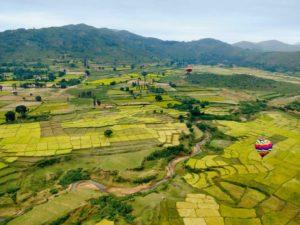A three-hour drive from Vizag, this tiny hill station offers plenty to revel in. With a stunning landscape of mountains, waterfalls, and mustard and sunflower fields, Araku Valley is fast becoming a sought-after ballooning destination.
I must confess, I hadn’t heard of the Araku Valley until the day I was hurtling towards it in a jeep. It is one of Andhra Pradesh’s ‘best-kept secrets’—at least outside of the state, because the place is otherwise usually teeming with local tourists and visitors from neighbouring Odisha.

It is a variegated valley with lofty mountains, deep jungles, waterfalls and twirling streams. Fields of paddy, mustard, sunflower and spice paint the valley in a striking palette of colours. Keeping you company on the winding road towards Araku are the Anantagiri Hills and the coffee plantations that produce the famed Araku coffee, which is now being retailed as a premium lifestyle drink in Paris.
Spread over 36 square kilometres, Araku is also home to numerous tribal communities. “Some of them still hunt and live the way their ancestors did,” says Kaushik Mukherji, advisor to A.P. Tourism. The valley, I conclude, truly is an anthropologist’s dream come true.
Araku Valley is flanked by Galikonda, Raktakonda, Chitamogondi and other exotic-sounding mountains. I am told that the best way to travel to Araku from Vizag is by train; the route is considered to be one of the most picturesque rail journeys in India, with the train chugging through 46 tunnels, bridges, and deep valleys.
However, a four-wheel drive into the valley, which is what I opted for since the rail tracks were under maintenance, can be equally exhilarating—and hair-raising. The journey is dotted with spots for impromptu picnics, viewing decks and food stalls. Araku is famous for its coffee, spices and smoky bamboo chicken—a dish where chicken chunks marinated with coriander and spices are stuffed into bamboo stems, covered with sal leaves, and cooked on hot coals for 30 minutes with no oil or water. It’s delicious.
From November to December, Araku Valley resembles a Yash Chopra film. Every frame is filled with acres of yellow mustard and sunflower fields, and the landscape turns dreamy. A 100-rupee note will buy you access to the fields where you can take selfies, ‘us-sies’ and everything in between, hands outstretched a la Shah Rukh Khan.

According to folklore, when gods and humans freewheeled across heaven and earth, a cow had fallen into the caves through a hole on the top. Instead of breaking a leg or two, the bovine was later found intact, and frolicking, in the Gosthani River flowing nearby. Scientifically, however, the caves have been carved out by subterranean streams flowing towards the river. Legends are always more interesting than facts!
The beautiful stalactites and stalagmites in the caves have clearly inspired the imagination of visitors, who see temples, mountains, rishis, gods and goddesses, animals and birds in these formations. I found the stalagmite resembling the human brain to be an extraordinarily creative twist of nature. The 656-foot-long cave is 2,050 feet deep. The 1,150-foot-long trek inside the caves can be an animated experience (the multi-coloured lights installed inside the caves notwithstanding). There is a naturally formed lingam deep inside the cave, unsurprisingly then tribal communities throng here during Shivaratri.
The valley, especially during full bloom, is an adventure junkie’s delight, ripe with trekking trails through dense jungles. It is also poised to become a ‘ballooning destination’. The Araku Hot Air Balloon Festival, co-organised by the Andhra Pradesh tourism board, saw 16 teams from 13 countries.

Later, sitting outside one of the glamping tents in a clearing, watching the sky dotted with colourful balloons, surrounded by mountains on one side and jungles on the other, I realised Araku is not your average comfort-holiday destination, instead it is a destination of experiences—both tangible and intangible. It is best enjoyed slowly, while sipping wine or some Araku coffee. #KhabarLive
